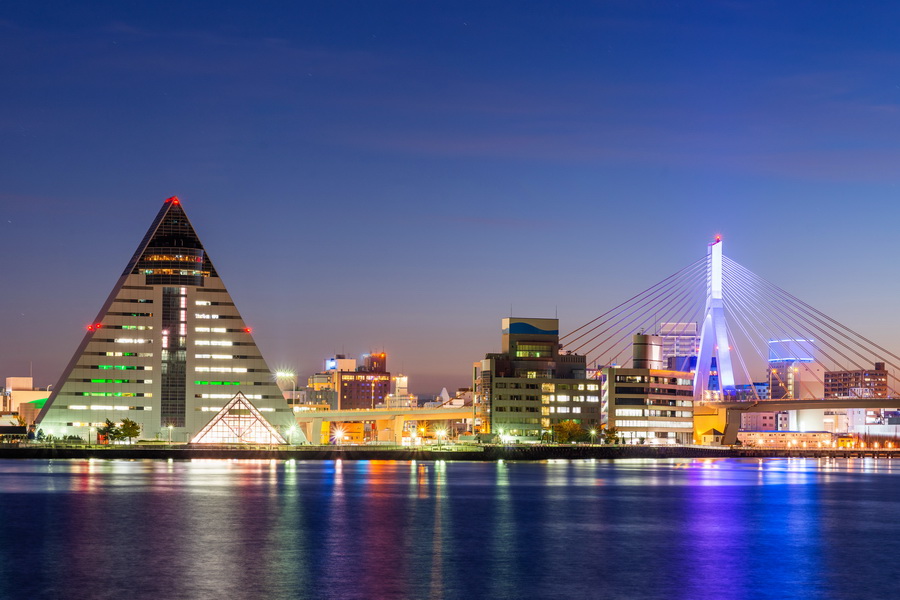Tours, Places to Visit, and Things to Do in Aomori
Aomori City (青森市) is a lively port city on the island of Honshu or Honshū (本州) and serves as the capital of Aomori Prefecture (青森県) in Japan’s Tohoku region (東北地方). Located at the northern tip of Honshu, this picturesque coastal city is a diverse destination that offers a captivating insight into the region’s thousands of years of history, world-class museums, the iconic Fuji apple, and a range of natural attractions – from mountain trails to breathtaking sunsets over the gulf.
Covering more than 800 km² which makes it even larger than New York City, Aomori has a relatively small population of 265,000. The city is flanked by volcanic mountains to the south and Aomori Bay, part of Mutsu Bay (陸奥湾) to the north.
Aomori is renowned for two main features: its record-breaking snowfall in winter making it the snowiest city in the world, and the spectacular Aomori Nebuta Matsuri Festival (青森ねぶた祭) in summer, which attracts millions of visitors from across Japan and beyond.
Discover more about this fascinating destination in our comprehensive Aomori Travel Guide.
Aomori Tours
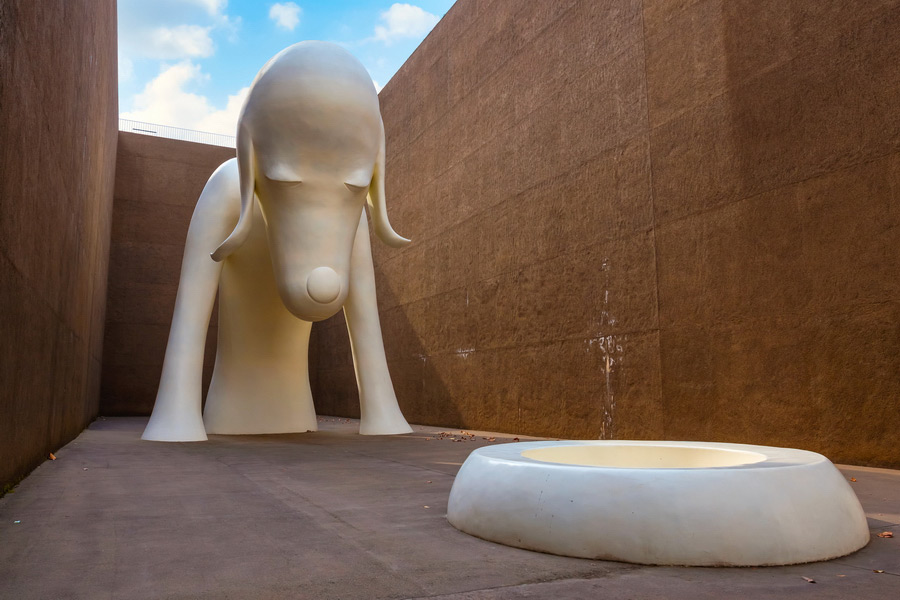
Most visitors travel to Aomori to experience its most famous festival, the Nebuta Matsuri (ねぶた祭り) – a spectacular celebration that draws over 3 million attendees each year. In addition to the vibrant festivities and lively entertainment, the city boasts a variety of other tour options that are worth exploring.
Day trips from Tokyo. Although Aomori may seem remote from Japan's major urban centres with a distance from Tokyo to Aomori that is over 700 kilometres, high-speed trains reduce travel time to just around four hours. This makes Aomori an unexpectedly convenient destination for a short escape. A typical Aomori day trip includes a leisurely stroll around the harbour, sightseeing at Aomori UNESCO World Heritage sites, and visits to the city's standout museums. Many tours also begin at the ASPAM (Aomori Sightseeing Products Mansion) Visitor Centre, which offers panoramic views and valuable local insights.
The 2–3 days Aomori tours provide ample time to immerse in the city’s culture and history. These multi-day itineraries are also perfect for visitors planning to attend the Aomori Festival and enjoy everything that this remarkable event has to offer.
Wellness tourism. Wellness-focused holidays at traditional ryokans are especially popular in Aomori. These rejuvenating trips typically last between three and ten days. Many travellers opt for Sukayu Onsen (酸ヶ湯), which is widely regarded as the best onsen in Aomori. Renowned for its healing properties, it’s a beloved choice for those in search of relaxation and renewal.
Mountain tours and outdoor recreation. Aomori is bordered to the south by the stunning Hakkoda Mountains (八甲田山系), which even extend right into the city limits. This proximity provides easy access to a variety of hiking trails, picnic spots, and scenic cable car rides on the Hakkoda Ropeway, making it a top destination for outdoor lovers.
Water activities. As a coastal city, Aomori excels in offering a range of water-based recreational activities. The beaches – such as Aomori Ekimae Beach (青森駅前ビーチ), Aburakawa Furusato Beach (油川ふるさとビーチ), and Asamushi Beach (浅虫ビーチ) – welcome swimmers during July and August. Visitors can also enjoy boating, kayaking, and canoeing. For a truly memorable experience, consider embarking on a cruise from Aomori Harbour – a cruise ship excursion here is sure to be a highlight of your trip.
Best Time to Visit Aomori
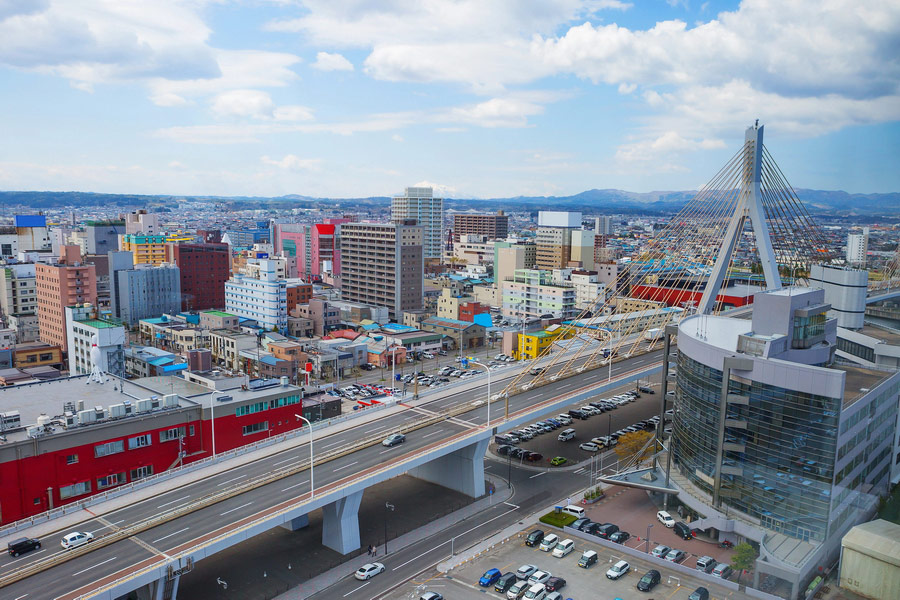
The best time to visit Aomori is in late April and early May, when the Aomori cherry blossom are in full bloom. Typically, the trees begin to blossom between April 22 and 25. Late spring in Aomori brings pleasant temperatures, averaging between 10–15°C, along with and relatively low rainfall, making it a perfect season for walks, sightseeing, or even a picnic beneath the blossoms.
Another ideal time to explore this northern city is during the summer, particularly in August. Aomori in summer experiences milder temperatures compared to Japan’s southern cities, rarely exceeding 27–28°C. As a result, many travelers from warmer regions head north to unwind and escape the heat. This season also coincides with the city most famous cultural celebration – the Nebuta Matsuri Festival.
Autumn in Aomori is another highly sought-after season for tourism. In September and October, the Aomori weather remains warm enough for hiking and exploration, with temperatures ranging from 24°C in early September to around 8°C by late October. Autumn in Aomori is renowned for its stunning scenery: the vibrant reds and golds of the mountain forests, combined with the colourful foliage lining the city streets, create postcard-worthy landscapes that draw crowds of visitors.
Aomori City in winter is renowned for its extraordinary snowfall – the city holds the title of the snowiest city in the world. Aomori average snowfall reaches an incredible 8 meters annually. Visit Aomori city in November or December to experience a true winter wonderland: the entire region transforms with towering snowdrifts, sparkling ice sculptures, and frost-covered tree branches, creating ethereal shapes reminiscent of “snow monsters”. Winter sports and seasonal festivals are also in full swing during this magical time.
In winter, Aomori's snowdrifts can reach several metres high, which historically posed challenges for daily life – vehicles had to navigate between towering walls of snow, and residents were sometimes trapped in their own yards. But in recent years, the city has turned this challenge into a major opportunity for innovation. Today, Aomori has developed a pioneering system that harnesses the temperature difference between snow and air to generate electricity. This eco-friendly solution is already in operation, and future projects aim to improve it by using the region’s natural hot springs to further increase the thermal contrast and energy production.
History of Aomori
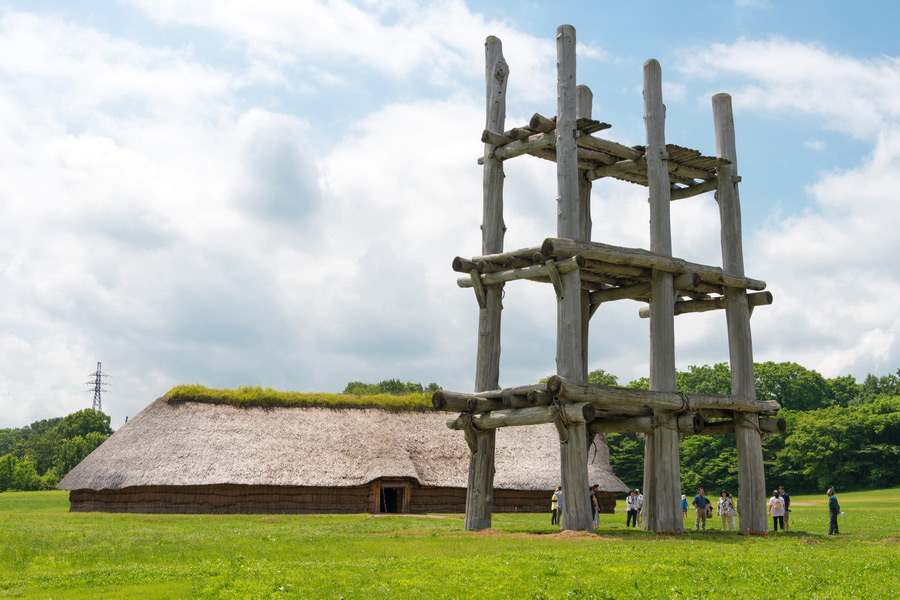
Aomori (青森市) which literally translates to “blue forest” derives its name from sailors, who referred to the coastal settlement of Uto (善知鳥村) in this manner, inspired by a forested hill visible from the sea. Over time, the name gained popularity and became official in the 17th century.
The region surrounding Aomori has been inhabited since ancient times with the city preserving historic sites that date back to the 4th and 5th millennia B.C. Among the most significant are the Sannai Maruyama site (三内丸山遺跡) and the Komakino site (小牧野遺跡), both of which are included on the list of the UNESCO World Heritage Sites and are key highlights of the Aomori UNESCO legacy.
Prior to the 11th century, Aomori was inhabited by the Emishi (蝦夷), an ethnic group culturally and linguistically distinct from the people of central Japan. The Emishi maintained their own traditions and lived independently in the Tohoku region for centuries. During the Heian period (平安時代), their territory came under the influence of the powerful Fujiwara clan (藤原氏). Gradually, the Emishi assimilated into the dominant Yamato (大和民族) culture, and their distinct identity faded from historical records.
During the Kamakura period, the Nambu clan (南部氏) ruled Aomori. In the 15th century, power shifted to the Tsugaru family, who oversaw the construction of a port, transforming Aomori into an important centre for trade and regional commerce.
Following the Meiji Restoration (明治維新), Aomori was officially recognised as a city in 1898. Throughout the 20th century, it served as a key strategic port, making it a target during World War II and resulting in significant damage from U.S. air raids. In the postwar period, Aomori experienced rapid recovery and emerged as one of the modern Japan's prosperous cities. Since 2006, it has held the status of Chūkakushi (中核市), recognising it as one of the country’s major regional cities.
What to Do in Aomori?
Places to visit in Aomori
The city of Aomori boasts a rich and diverse cultural heritage, featuring a variety of religious, historical, and modern landmarks. If you are attending a convention or business meeting in Aomori, you will not only have the opportunity to network with industry leaders and expand your professional network, but you can also take advantage of your visit to explore the historic city.
Temples and Shrines
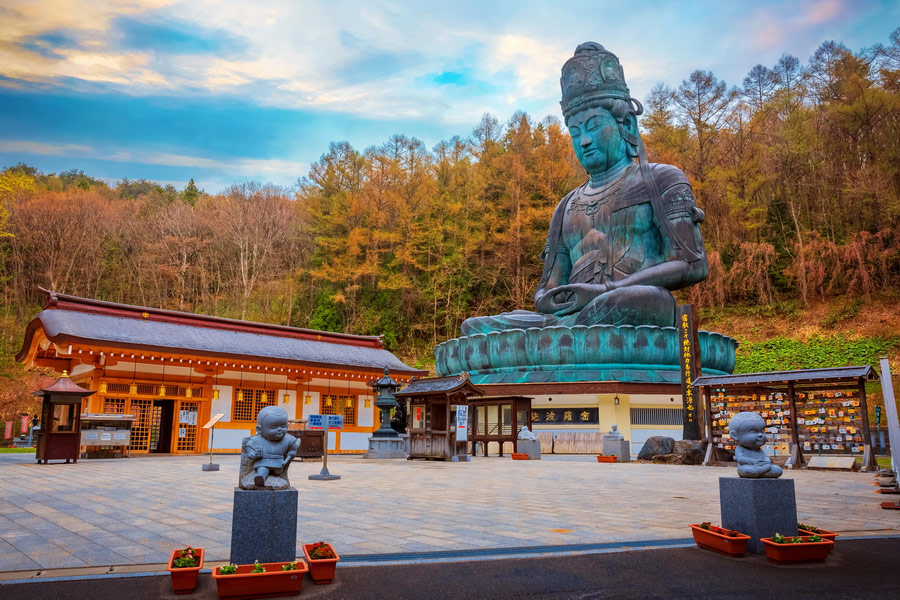
Seiryū-ji Temple (青龍寺) is a modern Buddhist complex that opened in 1982. The temple is notable for its two main temple halls constructed from cypress wood, a five-story pagoda that reaches approximately 40 metres in height and the Showa Daibutsu (昭和大仏) – a massive bronze statue often referred to as the big Buddha of Aomori. Standing over 21 metres tall, it is the largest seated bronze Buddha in Japan. Despite its impressive scale, this peaceful site remains less crowded than the more famous Buddha statues in Nara and Kamakura.
Aomori Port – The city’s coastline is home to several notable sights. Among them is the ASPAM tourist centre, a striking triangular building designed to resemble a sail. It’s one of the most recognisable modern structures in Aomori.
The scenic Aomori Bay Promenade and nearby Aomori Bay Bridge are ideal for a leisurely walk or a photo session by the harbour.
While visiting the port, be sure to explore the Ferry Memorial Ship Hakkodamaru (八甲田丸) – a large ferry that now serves as a museum. This vessel commemorates the era when ferries were the primary means of transport between Honshu (本州) and Hokkaido (北海道). This mode of travel changed in 1988 with the opening of the Seikan Tunnel (青函トンネル), an undersea rail connection that largely replaced ferry services.
Sannai Maruyama (三内丸山遺跡) is the restored site of an ancient Jōmon-period (縄文時代) settlement. More than 6,000 years ago, it was home to between 100 and 200 inhabitants, making it one of the largest known settlements of that era in Japan. Today, this significant archaeological site includes reconstructed dwellings, a museum, a library, and a distinctive three-story, tower-like structure that has become a symbol of the complex.
Museums
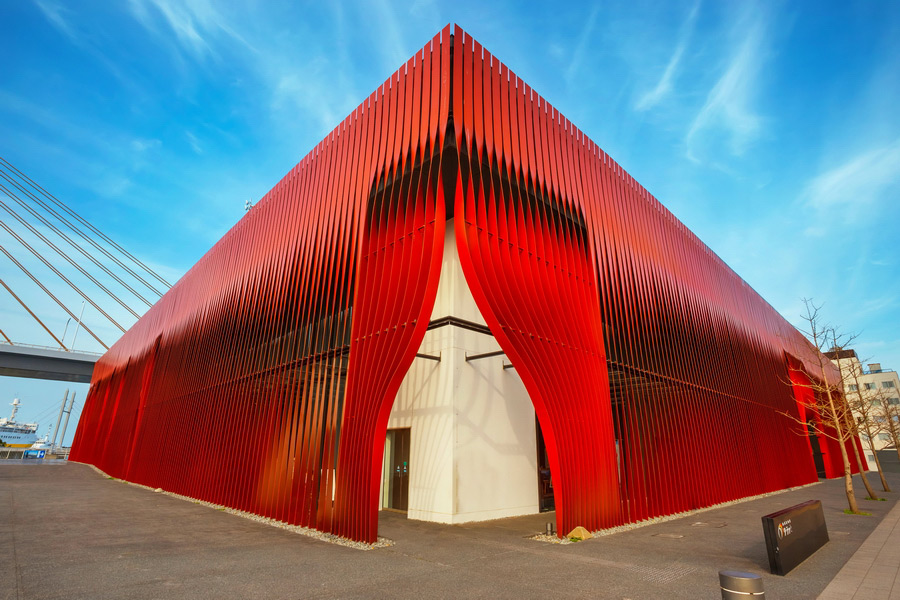
Aomori is renowned for its museums, offering visitors a chance to experience both the city's cultural heritage and its creative spirit.
Nebuta Museum Wa Rasse (ねぶたの家 ワ・ラッセ) is Aomori’s most famous museum, having opened in 2011. The bold red metal building, located near Aomori Harbour, immediately draws attention with its striking design. Inside, the museum showcases the iconic features of the city’s annual festival – including floats, costumes, masks, and figurines – bringing the Nebuta Matsuri to life year-round.
The Aomori Museum of Art (青森県立美術館) is another major attraction, well regarded both in Japan and internationally. Opened in 2006, it houses a vast collection of exhibits, many of which focus on Aomori’s local history and contemporary culture.
Among the most recognisable works on display is the towering 8.5-metre-long Aomori Dog, a sculpture by acclaimed Japanese artist Yoshitomo Nara (奈良 美智). The museum also features original works by Marc Chagall, including a massive 9-by-15-metre stage backdrop created for the ballet Aleko (1942), displayed in its own dedicated room.
The Aomori Contemporary Art Centre, opened in 2001, is a dynamic creative space nestled in the forest. Designed to support working artists, the centre includes a library, a park, and a range of studios and workshops that foster both artistic production and quiet reflection. Twice a year – in spring and autumn – the centre hosts an Artist-in-Residence programme, inviting Japanese and international artists to live and create on site. It also regularly holds exhibitions, masterclasses, and public events throughout the year.
Entertainment, Parks, and Shopping
Entertainment
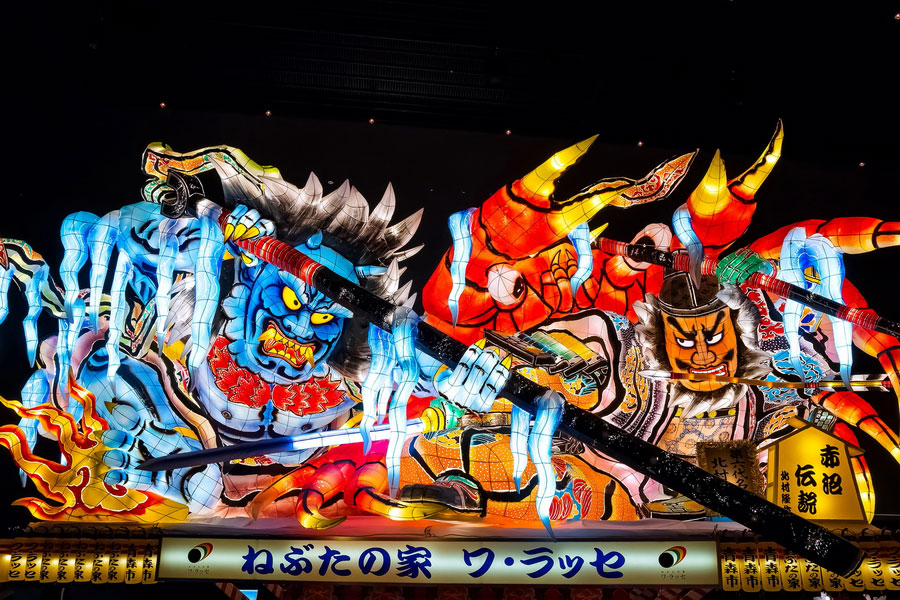
Aomori offers a wealth of entertainment, wellness, and outdoor recreation ensuring unforgettable experiences for solo travellers and families alike.
Experiencing the famous Aomori Nebuta Matsuri (ねぶた祭), held annually from August 2 to 7, is one of the best things to do in Aomori. This major summer festival is closely linked to Tanabata (七夕), the star festival rooted in the romantic legend of Princess Orihime (織姫) and the shepherd Hikoboshi (彦星), who, according to a Chinese-origin myth, are allowed to reunite only once a year as the stars Vega and Altair. There are also other fascinating origin stories behind the Nebuta Matsuri.
During the festival, the city comes alive with vibrant floats, lively music, and traditional dances filling the streets, and everyone is welcome to join in. The only requirement for participation is to wear a special costume, which can be easily rented or purchased at nearly any store during the festival period. For a more tranquil experience, consider visiting onsen in Aomori – hot springs that are an integral part of the region’s culture and wellness tourism. Set amid mountain forests or nestled within the city, these thermal baths offer a serene escape and are known for their therapeutic mineral waters. Many onsen in Aomori are attached to traditional inns, where guests can enjoy a quiet atmosphere, Japanese-style hospitality, and the chance to relax in open-air baths surrounded by nature.
Take a trip to the Asamushi Aquarium (浅虫水族館), a beloved destination in the region and one of the oldest facilities of its kind, having opened in 1924. This aquarium in Aomori is home to over 10,000 marine creatures, including around 400 rare species unique to the area. Highlights include a 15-metre underwater tunnel, dolphin performances, penguin exhibits, and a hands-on interactive zone where visitors can touch select sea animals.
Aomori Parks
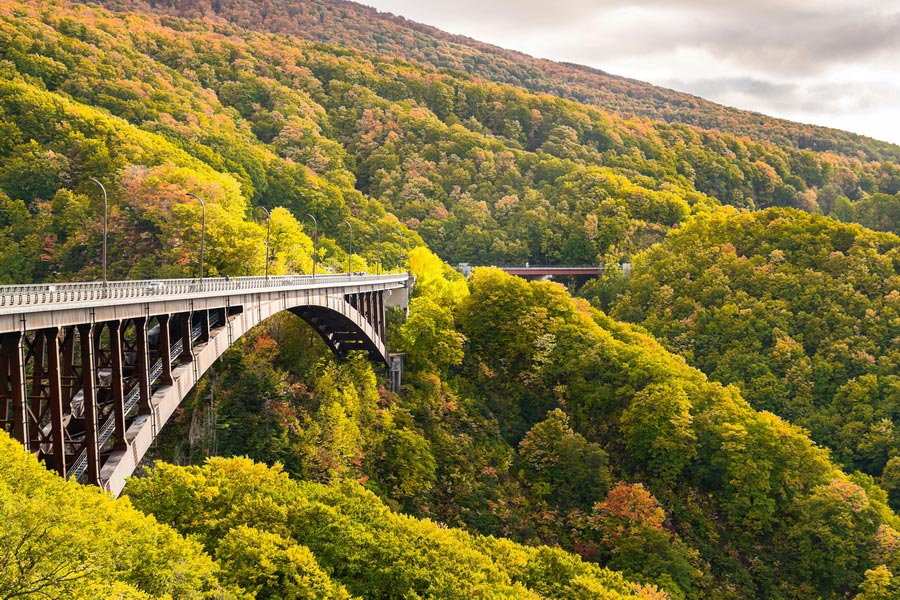
Spend a day unwinding in one of Aomori’s inviting parks. For a peaceful, scenic stroll, head to the refined Aomori Park (青い森公園) in the city center or the coastal Aoiumi Park (青い海公園). If you’re in the mood for a more active experience, Aomori City Sports Park Waku Waku Square (青森市スポーツ公園わくわく広場) offers plenty of space and energy for outdoor fun.
Outdoor enthusiasts can explore the Jōgakura Bridge (城ヶ倉大橋), the 360 metres longest arch bridge in Japan(1.180 ft). Towering 122 metres (400 ft) above the ground, it offers breathtaking views of the surrounding mountains and the valley far below.
Shopping in Aomori
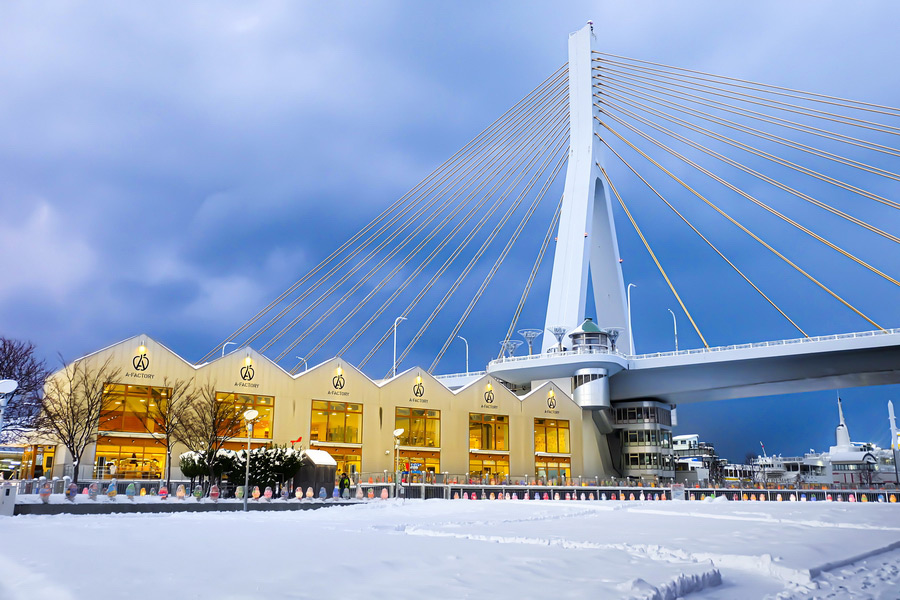
Aomori has no shortage of places to shop – from modern shopping centres like Sunroad to small local souvenir shops brimming with regional charm. The popular ASPAM tourist centre is a great stop not only for its panoramic views, but also for buying food products and souvenirs.
One notable place is the A-Factory, a stylish apple-themed facility situated near the port. Renowned for its cider production, it has become one of Aomori’s signature landmarks. Visitors can take part in a tasting tour or browse the store, which sells sweets, fresh produce, and most notably, a variety of goods made from locally grown Aomori apples.
What to buy in Aomori:
- Apple products – No visit to the region is complete without sampling or taking home something made from Aomori apples, the city’s most iconic export. Popular options include apple pies, cider, jams, and even apple-themed souvenirs like keychains, T-shirts, and handbags.
- Aomori festival souvenirs – Items related to the famous Nebuta Matsuri include colorful masks, T-shirts, unique towels, and other wearable or decorative goods. The Nebuta Goods shop offers a wide selection and is a must-visit for festival enthusiasts.
- Bunaco (ブナコ) – Crafted from local beechwood, these eco-friendly handmade items include bowls, lamps, and home decor pieces. Their clean, modern design fits beautifully in minimalist, industrial, or traditional interiors alike.
- Kogin-zashi (こぎん刺し) embroidery – Traditional clothing and accessories featuring intricate geometric patterns, often in white and indigo, this local folk art is distinctively Aomori.
- Tsugaru-nuri (津軽塗器) – Elegant lacquered wooden crafts made using time-honoured techniques. Each item showcases traditional patterns and a deep, glossy finish.
- Tsugaru Vidro (津軽びいどろ) – Aomori’s celebrated coloured glassware, handmade and vibrantly tinted. The colours are said to represent the shifting seasons of the region – from the soft pink of the Aomori cherry blossom in spring to the bold hues of summer during the Aomori festival.
Food in Aomori
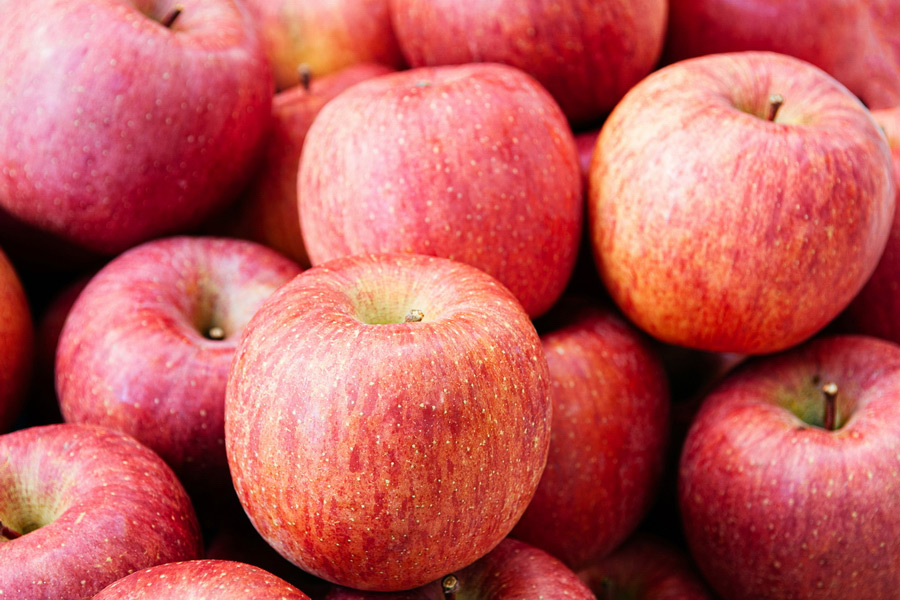
The cuisine of Aomori shares similarities with that of the rest of Japan. However, the city's northern location, its status as the main apple-producing prefecture, and a number of unique local traditions give many dishes distinctive regional flair.
What to try in Aomori:
- Aomori apples (青森りんご). Each year, Aomori produces approximately 500,000 tons of apples accounting for more than half of Japan’s total harvest. With around 50 varieties grown in the region, the sweet and crisp Fuji apple is the most beloved. Renowned for both its flavour and its long shelf life, the Fuji can stay fresh in the refrigerator for up to a year. Aomori apples are used in jellies, jams, pies, juices, and a wide range of desserts and snacks.
- Kaiyaki Miso (貝焼き味噌) is one of the best foods in Aomori. This dish consists of an egg omelette made with a touch of broth, seafood, and green onions, all cooked and served in a scallop shell. The shell not only enhances the presentation, but also imparts a subtle depth of flavour that characterises this unique Aomori food.
- Ginger-Miso Oden (生姜味噌おでん) is a comforting local variation of the classic oden (a one-pot simmered dish), infused with grated ginger. Especially popular during Aomori’s cold, snowy winters, this warming dish is both flavourful and satisfying.
- Ichigo-ni (いちご煮), despite its name, which translates to “strawberry soup”, this dish contains no berries. Instead, it features sea urchin and abalone in a clear broth, resembling the appearance of strawberries. This luxurious delicacy is typically served at the best restaurants in Aomori.
- Nokke-don (のっけ丼) is a must-try at the Aomori fish market, officially known as Furukawa Market. It consists of a rice bowl topped with your choice of fresh seafood. Visitors purchase coupons at the entrance and exchange them at various stalls for sashimi and delicacy toppings, allowing everyone to create their own custom seafood bowl. The fish here is as fresh as it gets, and the market’s central location near the train station makes it one of Aomori’s most popular foodie stops.
Aomori Restaurants
Aomori offers a wide variety of restaurants and cafes where you can enjoy everything from authentic Japanese fare to European cuisine. Some of the best Japanese restaurants in Aomori include:
- Osanai (お食事処 おさない) – Located in the city centre, this sought-after destination is especially known for its exceptional scallop dishes.
- Kawayoshi (かゝよし) – An atmospheric restaurant celebrated for its perfectly cooked fried eel.
- Michinoku Cuisine Nishimura ASPAM Store (みちのく料理 西むら アスパム店) – A well-regarded place offering classic Japanese dishes alongside a scenic view of Aomori Bay.
- Masunosuke (鱒の介) – A cosy, traditional eatery that serves fresh seafood in an authentic Japanese setting.
For those who prefer European flavours, Aomori has excellent Italian and Spanish options such as Casa del Cibo, Osteria Enoteca da Sasino located in Hirosaki, about 50 kilometres from Aomori, and Granada, among others. Vegetarian travellers will also find plenty to enjoy – many esteemed restaurants in Aomori include meat- and fish-free dishes made from the region’s fresh fruits and vegetables.
Coffee and pastry lovers will find plenty to enjoy in Aomori, from cosy local spots like Coffee Marron, COFFEEMAN Good, and Coffee Shop Mugiwara Boshi to familiar international favourites like Starbucks Coffee - Aomori & LOVINA.
Ryokans and Onsen in Aomori
Visiting onsen in Aomori offers more than just relaxation - it's a cultural experience deeply rooted in the region’s traditions. Whether nestled in remote mountain valleys or conveniently located in the city, these hot springs provide a chance to enjoy Aomori’s natural beauty while benefiting from the therapeutic properties of mineral-rich waters.
One of the most renowned hot springs in the prefecture is Sukayu Onsen (酸ヶ湯温泉), located 25 kilometres from Aomori City. This hydrogen sulphide spring is famous for its therapeutic properties, believed to aid in treating skin conditions, high blood pressure, digestive issues, and muscle and nerve pain. Sukayu also operates as a traditional ryokan, offering both Japanese-style tatami rooms and Western-style accommodations, along with an on-site restaurant. A specialty here is Sukayu Soba (酸ヶ湯そば) - buckwheat noodles made using the hot spring water, giving the dish a unique texture and flavour.
For those unable to reserve a room at Sukayu, nearby hotels such as Hakkoda and Jogakura provide excellent alternatives within easy reach of the onsen.
In addition to Sukayu, Aomori is home to several conveniently located hot springs: Aomori Machinaka Onsen (青森まちなかおおんせん), situated near Aomori Station, offers mildly alkaline waters that are gentle on the skin, relieve joint pain, and calm the nervous system. It is directly connected to the Aomori Center Hotel (青森センターホテル).
Aomori Gokurakuyu Onsen (極楽湯 青森) is a large bathing facility with a range of baths, including whirlpools and electric baths. Located about 4 kilometres south of the port, it is easily accessible by public transport from Aomori Station.
Just over an hour from Aomori City is Misawa (三沢市), home to Hoshino Resorts Aomoriya - a comprehensive retreat that includes a hot spring, traditional ryokan, and a theme park inspired by the vibrant Aomori Nebuta Matsuri. The mildly alkaline waters are known for their soothing effects on the skin and ability to ease aches and stress. Guests can enjoy a variety of baths, explore scenic surroundings, experience cultural displays, and attend seasonal festivals and exhibitions held throughout the year.
MICE
Aomori provides excellent facilities for business meetings, conferences, team-building events, and other MICE tourism activities. For large-scale gatherings, venues such as Link Station Hall Aomori (also known as the Cultural Hall), which can accommodate up to 2,000 attendees, and the ASPAM Centre featuring multiple rooms for meetings, conferences, and seminars, are highly regarded options. Major sporting events are typically hosted at Maeda Arena, which has a capacity of up to 5,500 guests. For smaller meetings, lectures, or workshops, venues like Hotel Aomori provide modern conference rooms and comfortable accommodations, making them well-suited for more intimate or business-oriented events.
Attending a convention or business meeting in Aomori gives you the chance to expand your professional network while also discovering the city’s rich history and unique cultural atmosphere.
How to Get to Aomori?
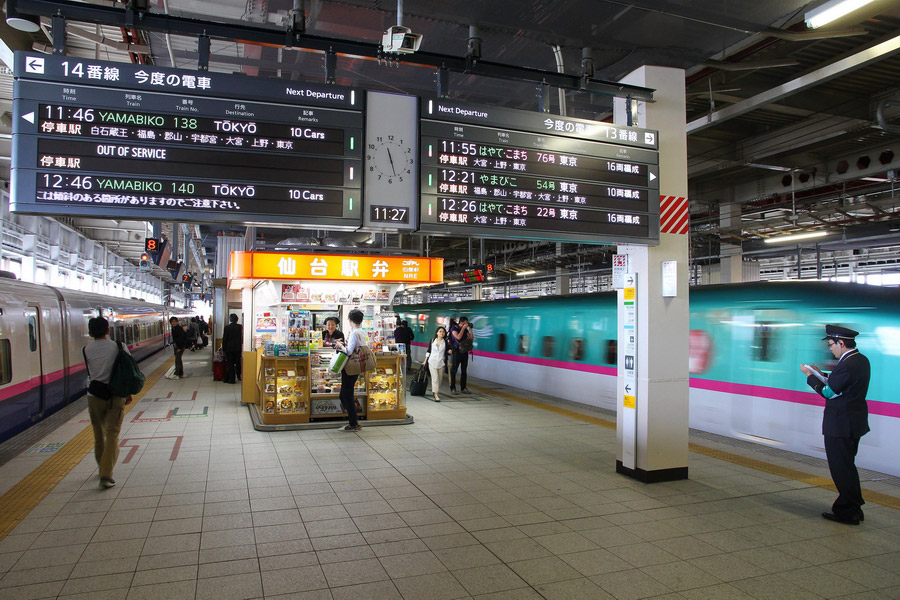
Aomori is the northernmost city on Honshu Island, located about 700 kilometres from Tokyo. You can reach it by train, car, bus, or aeroplane:
- Take the bullet train from Tokyo to Aomori – this is the most efficient and cost-effective option, making it the most popular way to travel to the city. The Hayabusa (はやぶさ) service on the Tohoku Shinkansen line (東北新幹線) takes you to Shin-Aomori Station (新青森駅). From there, you can transfer to the JR Ou Line (奥羽本線) and continue on to Aomori Station (新青森駅), which is located in the coastal area of the city and within walking distance of many main attractions. The total journey takes around four hours and is fully covered by the JR Pass.
- Flights to Aomori provide another convenient travel option from Tokyo. Direct flights operated by Japan Airlines (JAL) depart from Haneda Airport (東京国際空港) (HND) and arrive at Aomori Airport in approximately 1.5 hours. From the airport, it takes another 30 minutes by bus to reach JR Aomori Station (青森駅). When factoring in check-in and airport waiting times, the total trip from Tokyo to Aomori takes about three hours.
- The bus from Tokyo to Aomori is a good option for those who prefer overnight travel. The direct intercity bus on the Morioka Line has only two stops along the way. It departs from the Tokyo Disneyland bus stop and makes a stop at Tokyo Station (東京駅), Yaesu exit (八重洲口). The full journey lasts nearly 12 hours, departing at 21:00 and arriving in Aomori around 09:00 the next morning. If you are comfortable sleeping on the road, the bus to Aomori can be a relaxing and budget-friendly choice. Modern buses in Japan are equipped with power outlets, restrooms, air conditioning, and even air purifiers, offering a surprisingly high level of comfort.
City Transport in Aomori
Aomori is a fairly large city, and having a reliable form of transportation is essential for getting around. Standard city buses are available, but you can also rent a bike, book a taxi, or take advantage of the Nebutan-go (ねぶたん号) shuttle bus. This convenient service departs from JR Aomori Station (JR青森駅) and makes stops at nearly all the city’s major attractions.
For visitors, there are special passes designed to make transportation easy and affordable. The Aomori 1-day pass and 2-day pass offer unlimited rides on all forms of public transport for the duration of the pass. They’re a cost-effective way to explore the city, especially if you plan to visit multiple sites in a single day.
Languages Spoken
In Aomori, as in much of Japan, the predominant language spoken is Japanese. Locals use both the standard form, hyojungo (標準語), and the regional Tsugaru dialect (Tsugaru-ben, 津軽弁). Foreign languages, particularly English, are not widely spoken in Aomori. You can generally expect a basic level of English proficiency only from staff at hotels, restaurants, and tourist information centres. While most locals speak little English, they are usually willing to help – whether by pointing you in the right direction, using maps, or communicating through mobile translation apps. Additionally, many signs around Aomori are written in both Japanese and English, which can be a helpful guide for travellers.
Currency
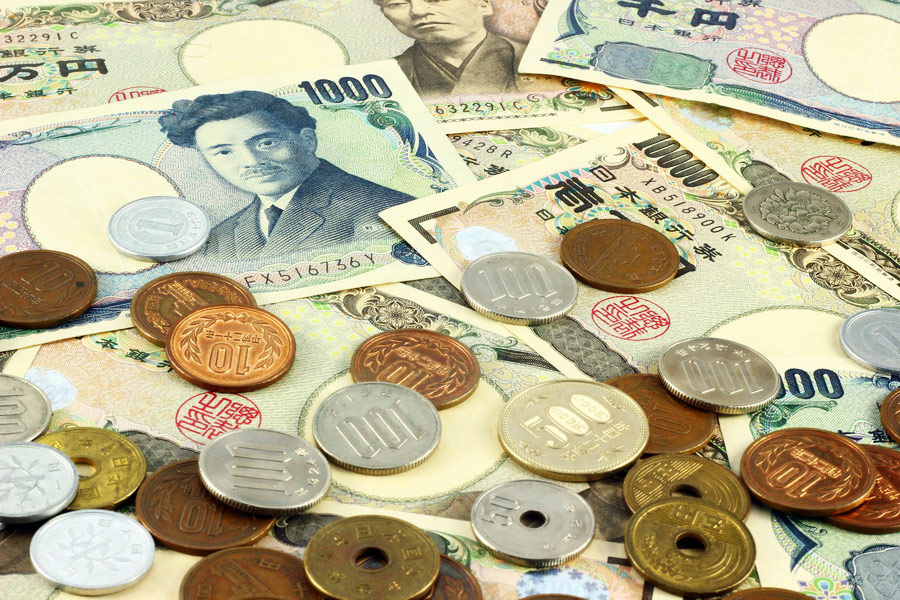
The official currency in Aomori is the Japanese yen (with 100 USD equalling approximately 14,000 yen). In many establishments – such as large hotels, shopping centres, and restaurants – foreign credit cards like Visa and MasterCard are widely accepted. However, cash is still preferred in smaller shops, temples, onsen, and other local spots. It’s a good idea to exchange and carry some yen in advance, especially if you plan to visit more remote or mountainous areas. For instance, even Sukayu Onsen, one of the most developed hot springs in Aomori, accepts only cash.
Is Aomori Safe?
Aomori is a modern Japanese city with a relatively small population. With its low crime rate, welcoming locals, reliable internet access, and a wide range of comfortable accommodations, it’s a safe and convenient destination – even for solo travellers.
The only time to exercise extra caution is during the Nebuta Matsuri in early August. During this iconic festival, the number of visitors to the city swells dramatically, with crowds potentially increasing tenfold. If you plan to join the celebrations, it is advisable to avoid the densest areas when possible and to book your transportation and accommodation well in advance, as trains and long-distance buses tend to fill up quickly during this peak season.


